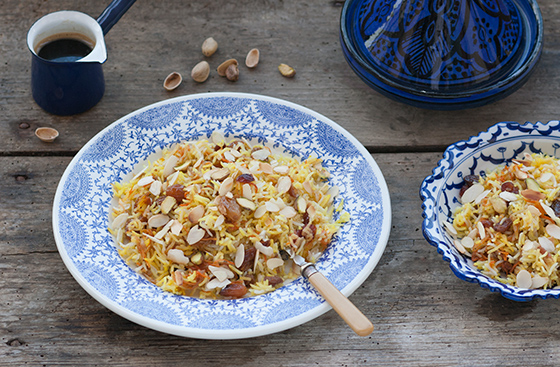One of the staples in many African, Asian, Middle Eastern and Latin American households is rice. When it comes to it, every country has its own traditional recipes, that can vary not only in ingredients, but also in methods.

However, there is one particular way of cooking rice that is basically common to most home cooks around the world: pilaf.
The English term pilaf comes from the Turkish pilav, which in turn comes the ancient Sanskrit pulāka. Due to the vast spread of the dish, there’s a number of spellings in different languages for the same way of cooking rice, including polou, palov, pilau, polu, polaao, pulao etc.
Pilaf and similar dishes are, in fact, common to Balkan, Middle Eastern, Caucasian, Central and South Asian, East African, North Indian, Latin American and Caribbean cuisines.
But what is pilaf? The term pilaf, although now standing for the cooked rice itself, is a method of cooking rice.
The traditional recipe calls for baking the rice in the oven, in a casserole with water and onions, but most cooks now cook the rice on the stove, since the result doesn’t change much.
Pilaf cooking is very similar to that of traditional couscous: all the water in which rice cooks should be absorbed, not drained, a procedure that greatly improves the nutritiousness of the finished dish, since the rice cooked this way, in fact, retains all its starches. This particular cooking method also keeps the grains of rice well separated, making it easier to serve as a side dish or as a mix-in for colorful salads and the like.
Pilaf is a very old way of cooking rice: one of the earliest literary references to pilaf can be found in the histories of Alexander the Great, who probably brought the recipe to Greece, while the first documented instructions about the recipe itself are by a tenth-century Persian scholar named Avicenna, who in his books on medical sciences dedicated a whole section to preparing various meals, including several types of pilaf.

The recipe
To prepare the rice, you need to consider that you want to use the same volume of liquids and of rice.
So, for instance, 1 cup of rice will need 1 cup of water to cook properly, plus a little bit of oil if you want to make sure that all the rice will cook nicely without sticking to the bottom of the pan. I advise you to use a non stick pan, anyway, just to be extra sure. If you’re the type of person that likes his/her pilaf a bit burned on the bottom, you can still obtain the same result by cooking the rice a little longer.
So, bring the water to a boil in a non stick pan with a pinch of salt (don’t forget it will all remain inside the rice, because all the water will be absorbed) and a tablespoon of olive oil; when the liquids begin to boil, pour in the rice and close the pan tightly with a lid.
Lower the flame and let the rice cook for some 15 to 18 mins, until all the water is gone.
If you increase the amount of rice you’re cooking, don’t forget to add 5 extra mins of cooking for every extra cup.
One of the staples in many African, Asian, Middle Eastern and Latin American households is rice. When it comes to it, every country has its own traditional recipes, that can vary not only in ingredients, but also in methods.






